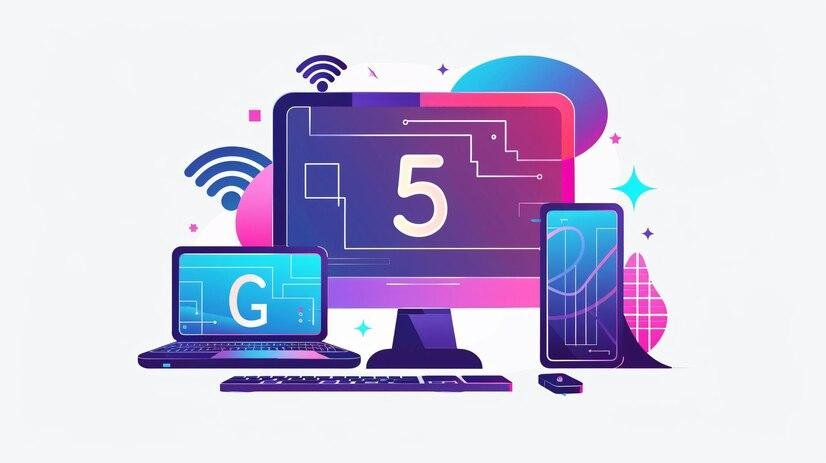As we move further into the digital age, the Internet of Things (IoT) is transforming the way we live and work. With the proliferation of connected devices, the demand for faster and more reliable communication networks has never been greater. Enter 5G technology: a game-changer that promises to revolutionize IoT applications across various industries. In this blog post, we’ll explore the crucial role of 5G software in the IoT era and how it enhances connectivity, speeds up data transfer, and improves overall system efficiency.
Understanding 5G Technology
5G, or fifth-generation wireless technology, offers significant improvements over its predecessor, 4G LTE. With its ultra-high speeds, reduced latency, and increased capacity, 5G is designed to accommodate the vast number of devices that comprise the IoT ecosystem. This technology supports advanced features such as network slicing, which allows multiple virtual networks to coexist on a single physical infrastructure, optimizing resources for different applications.
To dive deeper into how 5G is structured and its key features, you can check over here to find out more about this revolutionary technology.
The Intersection of 5G and IoT
In the IoT era, billions of devices—from smart home appliances to industrial sensors—rely on seamless connectivity to communicate with each other and exchange data. The integration of 5G software into the IoT landscape enhances this connectivity in several significant ways:
Enhanced Speed and Bandwidth
One of the primary benefits of 5G technology is its remarkable speed. With data transfer rates reaching up to 10 Gbps, 5G enables real-time communication between devices. This is particularly crucial for applications that require immediate response times, such as autonomous vehicles, remote healthcare monitoring, and industrial automation. By utilizing 5G software, these applications can operate with minimal lag, ensuring efficiency and safety.
If you want to learn more about the impressive speed capabilities of 5G and its impact on IoT, make sure to click this link here now.
Ultra-Low Latency
Latency refers to the delay between sending and receiving data. 5G dramatically reduces this latency to as low as 1 millisecond, making it ideal for IoT applications that rely on instant feedback. For instance, in smart factories, machines can communicate in real time, reducing downtime and improving production efficiency. Similarly, in healthcare, ultra-low latency is essential for remote surgeries and monitoring critical patient data.
For further insights on the significance of low latency in the IoT landscape, you can click to read more about how 5G is facilitating real-time applications.
Increased Device Capacity
The growth of IoT means an exponential increase in the number of connected devices. 5G technology is built to support up to 1 million devices per square kilometer, ensuring that urban areas can handle the dense concentration of devices without compromising performance. This scalability is vital for the implementation of smart cities, where numerous sensors and devices work together to optimize urban living.
To explore how 5G supports massive device connectivity, Find Out More about the infrastructure required for smart city applications.
Enabling Advanced Applications with 5G and IoT
The combination of 5G software and IoT paves the way for innovative applications across various sectors:
Smart Cities
5G technology plays a critical role in developing smart cities, where interconnected devices monitor traffic, manage energy consumption, and enhance public safety. With real-time data processing, city planners can make informed decisions that improve urban living. For instance, smart traffic lights can adapt to traffic conditions, reducing congestion and emissions.
Healthcare Innovations
The healthcare sector stands to benefit immensely from the synergy between 5G and IoT. Wearable devices can continuously monitor vital signs and transmit data to healthcare providers in real time. This not only enhances patient care but also enables remote consultations and telemedicine services. In emergencies, quick access to patient data can be life-saving.
Industrial Automation
In the industrial sector, 5G empowers IoT devices to communicate seamlessly, optimizing production lines and supply chains. Sensors can detect equipment malfunctions before they occur, reducing downtime and maintenance costs. Additionally, augmented reality (AR) applications, enabled by 5G, can assist technicians in real time, improving efficiency and safety on the factory floor.
Challenges and Considerations
While the integration of 5G software into the IoT landscape offers numerous benefits, it is not without challenges:
Infrastructure Costs: Implementing 5G networks requires significant investment in infrastructure. Cities and companies need to collaborate to ensure the necessary equipment is installed.
Security Concerns: The vast number of connected devices increases the potential attack surface for cybercriminals. Robust security measures must be in place to protect sensitive data.
Regulatory Issues: As technology evolves, regulatory frameworks must adapt to ensure fair access and privacy for users.
Addressing these challenges will be critical to realizing the full potential of 5G in the IoT era.
The Future of 5G and IoT
Looking ahead, the role of 5G software in the IoT ecosystem will continue to expand. As technology matures, we can expect even more sophisticated applications, including enhanced artificial intelligence (AI) capabilities, improved edge computing solutions, and greater interoperability among devices. This convergence will lead to more personalized and efficient services across all sectors.
Conclusion
In conclusion, the integration of 5G software in the IoT era is pivotal for enhancing connectivity and enabling innovative applications across various industries. With its high speeds, ultra-low latency, and increased capacity, 5G technology is set to revolutionize how we interact with the world around us. As we continue to embrace this transformation, it’s essential to address the challenges and ensure that we build a secure and efficient infrastructure for the future.



More Stories
Tax Benefits of Using Virtual Offices
What Are Industrial Cable Glands and How Do They Work?
Benefits of Reviewing PTE Mock Test Results